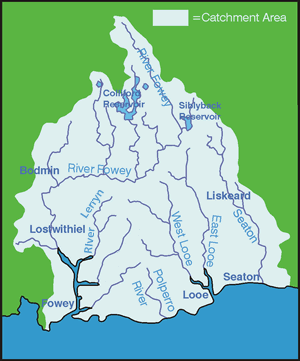River Catchments - EAST and WEST LOOE
Together with the Seaton and the Fowey catchments, the East and West Looe catchments rise at approximately 300m and drain an area of south east Cornwall from the southern slopes of Bodmin Moor to the south coast. From the headwaters to the estuary, both East and West Looe rivers fall steeply at 13m/km and 10m/km respectively and are subject to rapid rises and falls in water levels after periods of rainfall.
The catchment is very rural in character, ranging from open moorland to rolling hills intersected by steep sided river valleys. Historically, mining activity was widespread in the upper catchment which has left a legacy of abandoned mines and workings throughout the area.
The underlying geology within the Looe catchment is characterised by Devonian sedimentary rocks (slates, shales and thin limestone) with the bedrock forming one of the few groundwater aquifer reserves found in Cornwall. In addition to supporting numerous drinking water supplies in the catchment, these groundwater supplies facilitate river baseflow during period of low rainfall. Due to the shallow water tables and low porosity of the geology, groundwater reserves are highly vulnerable to contamination from the escape of pollutants into the soil.
Most of the advisory visits in the East and West Looe catchments focused on the middle sections of the river; 49 farms were visited and advice given covering an area of 2,847 hectares. Agricultural activity is dominated by dairying, beef and sheep rearing and various arable enterprises.
Twenty four kilometres of watercourses received management advice such as coppicing, fencing and erosion control measures. A significant area of the catchment is under arable production and consequently measures such as spray savings and soil loss prevention were recommended. Seven farms received fencing grants totalling 3.5 km in total.
The Lostwithiel and District Anglers have fishing waters on the Looe and received advice for the beat from Church Bridge to Sowdens Bridge, a length of 3km.
